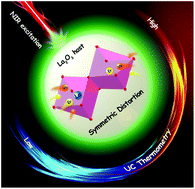Local symmetric distortion boosted photon up-conversion and thermometric sensitivity in lanthanum oxide nanospheres†
Abstract
It is essential to simultaneously boost the luminescence intensity and thermometric sensitivity of up-converted optical thermometers towards potential biomedical sensing applications. Herein, the effects of local site symmetry on the up-conversion (UC) emission and thermal sensing ability in trigonal-phased La2O3:Er3+/Yb3+ nanospheres were qualitatively explored using cubic-phased Lu2O3 and Y2O3 with a similar shape and phonon energy as contrasts. Under 980 nm light excitation, much stronger UC emissions were detected in La2O3 samples than that in cubic Lu2O3 and Y2O3 samples, and the possible mechanisms were elaborately proposed using Eu3+ as a luminescent probe. Thermo-responsive emission intensity from 2H11/2/4S3/2 levels was monitored to evaluate the absolute sensitivity of three samples, which strongly depends on the dopant-induced local site symmetric distortions according to the Judd–Ofelt theory. The potentiality of La2O3:Er3+/Yb3+ for sub-tissue thermometry was also validated by ex vivo experiments. Results open a promising avenue for realizing highly sensitive thermometry with a large signal-to-noise ratio in sub-tissues via finely tailoring the local site symmetry.

- This article is part of the themed collection: International Year of the Periodic Table : Lanthanides for Precision Therapy and Beyond


 Please wait while we load your content...
Please wait while we load your content...